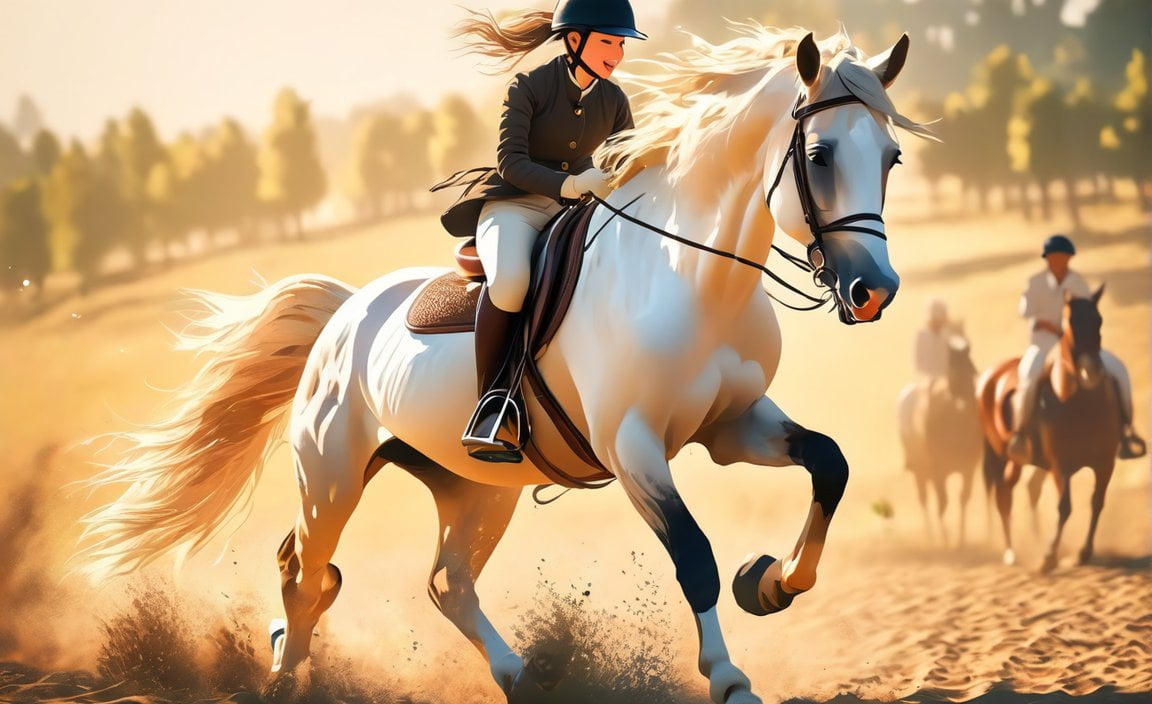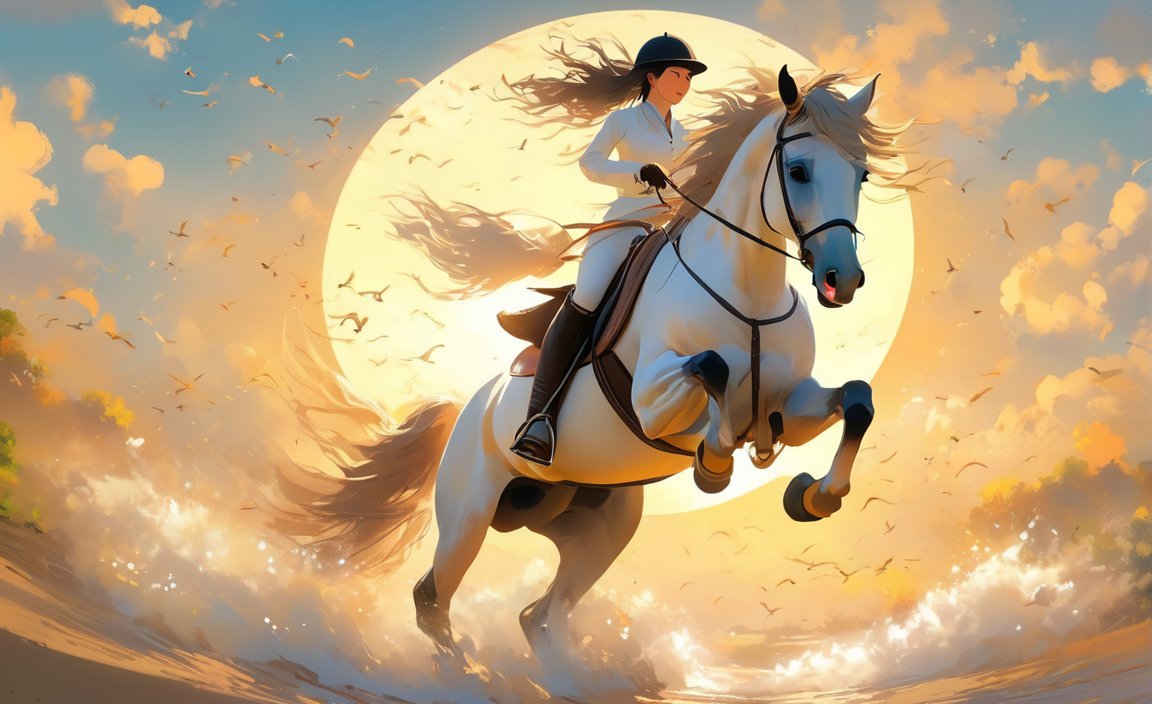Horse riding, an equestrian pursuit that has captivated humankind for millennia, is a symphony of movement, trust, and exhilaration. From the gentle sway of a walk to the exhilarating gallop, horse riding offers a unique connection with these majestic creatures, providing an escape into a world of grace and athleticism.
A Sport Rooted in History

The equestrian bond between humans and horses stretches far back in time, weaving its way through the tapestry of ancient civilizations. Horse riding transcended mere transportation, becoming an integral part of human society, shaping cultures, and influencing the course of history.
Horse Riding: An Integral Part of Ancient Societies
In ancient Greece, horse riding was held in high esteem, not just as a practical skill but also as a sport and a symbol of status. Horse racing was a revered event in the Olympic Games, captivating audiences with its thrilling displays of speed and skill. Skilled horsemen were highly regarded for their prowess, their mastery over these majestic creatures a testament to their courage, athleticism, and horsemanship.
Beyond the Arena: Horses in Warfare and Transportation
Horses played a pivotal role in warfare, their powerful gaits and ability to carry armored riders providing a decisive advantage on the battlefield. From the mounted archers of the Parthian Empire to the cavalry charges of medieval knights, horses were a formidable force, shaping the outcomes of countless battles.
Beyond the battlefield, horses were indispensable for transportation, connecting far-flung communities and facilitating trade. They carried goods and people over vast distances, their strength and endurance enabling the movement of essential supplies and the forging of trade routes that linked civilizations.
A Legacy of Equestrian Traditions
The legacy of horse riding extends beyond its practical applications, deeply embedded in cultural traditions and equestrian practices. From the intricate dressage movements of haute école to the exhilarating rodeo competitions of the American West, horse riding has evolved into a diverse array of disciplines, each showcasing the unique bond between humans and horses.
The equestrian world is steeped in traditions, from the etiquette of the stable to the camaraderie among riders. The language of horsemanship carries a rich history, with terms like “gait” and “bit” echoing through the ages, preserving the knowledge and practices passed down through generations of horsemen and horsewomen.
Horses: Companions and Partners
Horses have become more than just domesticated animals; they are companions, partners, and a source of inspiration. Their majestic presence, intelligence, and capacity for forming strong bonds with humans have captivated people for millennia. Horse riding offers a unique connection with these creatures, allowing us to experience their strength, grace, and spirit firsthand.
The equestrian world continues to thrive, with horse riding enthusiasts embracing the sport, leisure riders enjoying the tranquility of trail rides, and competitive riders striving for excellence in equestrian disciplines. Horses remain an integral part of our lives, their presence a reminder of the enduring bond between humans and these remarkable creatures.
The Sole Purpose of Riding
Horses hold a unique distinction among domesticated animals, bred specifically for the purpose of riding. Their physical attributes, honed over centuries of selective breeding, make them ideal companions for this pursuit. Unlike other domesticated animals primarily bred for meat, milk, or labor, horses have evolved to carry the weight of riders comfortably and efficiently.
A Symbiosis of Strength and Grace
Horses possess a remarkable combination of strength and grace, essential qualities for riding. Their strong backs, powerful muscles, and flexible joints allow them to support riders of various sizes and weights. Their smooth gaits, ranging from the gentle walk to the exhilarating gallop, provide a comfortable and enjoyable ride for their human counterparts.
The Evolution of Horse Breeds for Riding
The diversity of horse breeds reflects the specialized adaptations for riding. From the towering Shire horses bred for pulling carriages to the agile Thoroughbreds known for their racing prowess, each breed possesses unique traits that enhance their suitability for specific riding disciplines.
Beyond Physical Attributes: The Intelligence of Horses
Horses are not merely passive carriers; they possess remarkable intelligence and an innate ability to communicate with humans. Their keen senses and responsive nature allow them to form strong bonds with their riders, responding to cues and commands with precision and trust.
A Partnership of Trust and Respect
Horse riding transcends mere physical exertion; it is a partnership built on trust, respect, and mutual understanding. Riders learn to communicate effectively with their horses, understanding their cues and anticipating their needs. This harmonious relationship forms the foundation for a truly enjoyable and rewarding riding experience.
The Enduring Legacy of Riding
The legacy of horses as riding companions extends far back in time, with evidence suggesting that horse riding may have originated as early as 4500 BC. Over the centuries, horses have played a pivotal role in human history, from the mounted warriors of ancient civilizations to the cowboys of the American frontier.
Today, horse riding remains a popular and diverse activity, encompassing a wide range of disciplines, from competitive sports to leisurely trail rides. Whether it’s the thrill of a competitive race or the tranquility of a countryside ride, horses continue to offer a unique connection with nature and a source of joy and fulfillment for riders worldwide.
A Towering Giant: A Testament to Horse Diversity
Sampson, a Shire horse of exceptional height, stands as a testament to the incredible diversity of horse breeds. At an astounding 7 feet 2 inches tall, Sampson towered over his equine counterparts, his imposing presence a reminder of the vast range of sizes and characteristics within the horse kingdom.
A Breed of Strength and Stature
Shire horses are renowned for their strength and massive stature, traditionally bred for pulling heavy loads. Their powerful muscles, sturdy limbs, and robust frames make them well-suited for draft work, hauling carriages, and even plowing fields.
Sampson, with his exceptional height, embodied the Shire breed’s impressive characteristics. His towering presence commanded attention, exemplifying the breed’s gentle temperament and willingness to work despite their imposing size.
A Spectrum of Breeds, Each with Unique Traits
The equine world encompasses a diverse array of breeds, each with its own unique characteristics, adaptations, and purposes. From the agile Thoroughbreds, known for their speed and racing prowess, to the gentle Shetland ponies, beloved for their affectionate nature, the horse kingdom exhibits a remarkable range of sizes, gaits, and temperaments.
This diversity reflects centuries of selective breeding, as humans have sought to enhance specific traits for various purposes. From the powerful draft horses to the graceful dressage mounts, each breed has evolved to excel in its respective field.
Diversity Beyond Size: Temperament, Gaits, and Adaptability
The diversity of horse breeds extends beyond mere size. Temperament, gaits, and adaptability play significant roles in distinguishing breeds and their suitability for different disciplines. From the spirited Arabians, known for their fiery personalities, to the calm and collected Clydesdales, each breed possesses unique traits that make them well-suited for specific riding styles and activities.
A Celebration of Equine Diversity
Sampson, with his towering height, stands as a symbol of the incredible diversity within the horse kingdom. His legacy serves as a reminder of the vast range of sizes, temperaments, and gaits that exist among horse breeds, each with its unique contributions to the equestrian world.
Speed Demons of the Land: Unveiling the Horse’s Hidden Speed Potential
Horses, often admired for their elegance and grace, also possess a remarkable ability to accelerate and maintain impressive speeds. Their powerful muscles, efficient gaits, and lightweight skeletons make them true speed demons of the land, capable of outrunning many other terrestrial animals.
A Burst of Speed: Reaching Top Gear
Horses can reach astonishing speeds, with the Thoroughbred breed renowned for its ability to sprint up to 40 miles per hour in just a few strides. Quarter Horses, known for their sprinting prowess, can accelerate from 0 to 30 miles per hour in just two seconds. These bursts of speed are a testament to the horses’ powerful muscles and efficient gaits.
The Gallop: A Symphony of Speed and Efficiency
The gallop, the fastest gait of horses, is a marvel of biomechanics. During a gallop, the horse’s legs move in a synchronized pattern, propelling it forward with minimal energy expenditure. The flexible spine and powerful muscles of the horse allow it to maintain a high speed over long distances.
A Lightweight Skeleton: A Speed Enhancer
Horses’ lightweight skeletons play a crucial role in their speed. Their bones are strong yet porous, reducing overall weight without compromising strength. This lightweight structure allows horses to convert more energy into propulsion, making them more efficient runners.
Beyond Speed: Agility and Maneuverability
Horse speed is not just about straight-line sprints; it also encompasses agility and maneuverability. Horses can quickly change direction, navigate obstacles, and adapt their gaits to different terrains, making them versatile athletes in various equestrian disciplines.
Harnessing Speed for Sport and Competition
The horse’s impressive speed has been harnessed for centuries in various sports and competitions. Thoroughbred racing, a thrilling spectacle, showcases the breed’s exceptional speed and athleticism. Quarter Horses are celebrated for their sprinting abilities in rodeo events, while barrel racing tests horses’ agility and speed in a timed course.
Speed with Grace: A Fusion of Power and Elegance
Horses embody a unique fusion of power and elegance, combining their impressive speed with grace and agility. Their ability to burst into sprints, maintain a steady gallop, and maneuver with precision makes them true speed demons of the land, captivating onlookers with their athleticism and grace.
A Multifaceted Health Enhancer: Unleashing the Wellness Benefits of Horse Riding
Horse riding, often perceived as a leisure activity or competitive sport, also offers a surprising array of physical and mental health benefits. Far from being a mere pastime, horse riding engages the body and mind in a unique way, promoting overall well-being and enhancing various aspects of health.
Physical Health Benefits: A Full-Body Workout
Horse riding provides a full-body workout that engages numerous muscle groups, improving strength, flexibility, and coordination. The rhythmic movements of the horse stimulate core muscles, enhancing posture and stability. The legs, thighs, and glutes are also strengthened through the act of maintaining balance and controlling the horse’s gaits.
Cardiovascular Health: A Gallop Towards a Healthy Heart
Horse riding strengthens the cardiovascular system, improving heart health and endurance. The rhythmic movements of the horse elevate the heart rate, stimulating blood circulation and increasing oxygen delivery to the muscles. This sustained cardiovascular activity can lower blood pressure, reduce the risk of heart disease, and enhance overall fitness.
Balance and Coordination: A Symphony of Movement
Horse riding demands a high level of balance and coordination, as riders must synchronize their movements with those of the horse. This constant interplay between rider and horse enhances proprioception, the body’s awareness of its position in space. Improved balance and coordination can reduce the risk of falls and improve overall agility.
Mental Health Benefits: A Therapeutic Escape
Horse riding offers a therapeutic escape from the stresses of daily life, promoting relaxation and stress reduction. The rhythmic movements of the horse have a calming effect on the nervous system, reducing anxiety and promoting a sense of well-being. The connection with nature and the tranquility of riding can also enhance mood and mental clarity.
Focus and Concentration: A Mindful Ride
Horse riding requires a high level of focus and concentration, as riders must anticipate the horse’s movements and respond accordingly. This mental engagement helps to improve attention span, concentration, and reaction times. The mindful nature of horse riding can also reduce distractions and promote a sense of calm and focus.
A Holistic Approach to Wellness
Horse riding provides a holistic approach to wellness, addressing both physical and mental health. It promotes physical fitness, strengthens the cardiovascular system, enhances balance and coordination, and reduces stress. The connection with nature and the therapeutic nature of riding further contribute to overall well-being.
Embracing the Wellness Benefits of Horse Riding
Whether you’re an experienced equestrian or a curious newcomer, horse riding offers a unique opportunity to enhance your physical and mental health. Embrace the rhythmic movements of the horse, engage your mind and body, and discover the transformative power of this multifaceted wellness activity.
Equestrian Equipment: A Journey Through Time

Horse riding has evolved over millennia, and its evolution is intricately linked to the development of equestrian equipment. From the simple yet ingenious bit to the sophisticated saddles and stirrups of today, these tools have transformed the way we interact with horses, enhancing communication, control, and comfort.
The Bit: A Simple Tool with a Profound Impact
The bit, the oldest known piece of horse riding equipment, dates back to 3500 BC. This seemingly simple tool revolutionized horse riding by enabling riders to communicate with their horses more effectively. By applying gentle pressure to the horse’s tongue and bars of the mouth, riders could convey subtle cues, guiding the horse’s direction, speed, and gaits.
The evolution of the bit has been a continuous process, with various designs and materials developed over time. From the simple bone or wooden bits of ancient times to the more sophisticated articulated bits of today, the bit remains an essential tool for horse riding, allowing for a refined level of communication between horse and rider.
Saddles and Stirrups: Enhancing Comfort and Control
The saddle, another crucial piece of equestrian equipment, has undergone significant evolution over the centuries. Early saddles were simple pads or blankets, providing minimal comfort and support. However, as riding techniques evolved, so did saddle designs, incorporating features like horns, pommels, and seats to enhance comfort and control.
The invention of stirrups further transformed horse riding, providing riders with a secure connection to the horse and enabling them to stand up in the saddle for greater stability and control. Stirrups also allowed for more powerful and controlled riding techniques, making them indispensable for activities like jousting and warfare.
Beyond Essentials: Specialized Equipment for Diverse Disciplines
Equestrian equipment has expanded beyond the essential bit, saddle, and stirrups to encompass a wide range of specialized gear tailored to specific riding disciplines. From the lightweight saddles and bridles of racing thoroughbreds to the protective vests and helmets of polo players, each piece of equipment serves a unique purpose, enhancing the performance and safety of riders in their respective disciplines.
A Testament to Human Ingenuity and the Human-Horse Bond
The evolution of equestrian equipment is a testament to human ingenuity and the enduring bond between humans and horses. From the simple bit that revolutionized communication to the sophisticated saddles and stirrups that enhance comfort and control, these tools have transformed horse riding, making it more enjoyable, effective, and accessible for riders worldwide.
Equine Memory: A Testament to Their Intelligence
Horses, often admired for their physical prowess and grace, also possess remarkable cognitive abilities, including an exceptional memory. Their ability to store and retrieve memories over extended periods extends beyond mere recognition and recall, demonstrating a depth of understanding and emotional connection that sets them apart from many other animals.
A Memory for Faces and Places
Horses possess an impressive ability to recognize and remember individual people, often distinguishing between familiar faces even after years of separation. Studies have shown that horses can recognize up to 50 different people, recalling their appearance and associating them with specific experiences or interactions.
This ability to recognize faces extends to places as well. Horses can form strong memories of specific locations, navigating familiar routes and recognizing landmarks even after lengthy absences. Their spatial memory plays a crucial role in their ability to navigate and forage in their natural environments.
Emotional Memory: Forming Strong Bonds with Humans
Horses’ memory extends beyond mere recognition and recall, encompassing the emotional aspects of their experiences. They can form strong bonds with humans, remembering positive interactions and responding with affection and trust. This ability to retain emotional memories contributes to the deep connection that many people share with horses.
A Testament to Equine Intelligence
The remarkable memory of horses highlights their intelligence and capacity for learning. Their ability to store and retrieve memories allows them to learn from experiences, adapt to new environments, and form strong bonds with humans. This cognitive capacity makes them valuable partners in various activities, from companionship and leisure riding to competitive sports and therapeutic interventions.
Memory: A Cornerstone of the Human-Horse Bond
The equine memory plays a pivotal role in the human-horse bond. Horses’ ability to recognize and remember their human counterparts fosters trust, affection, and a sense of shared experiences. This mutual understanding forms the foundation for a deep and meaningful relationship between humans and horses.
Appreciating Equine Intelligence
As we appreciate the remarkable memory of horses, we also recognize their intelligence and capacity for learning and forming strong bonds. Understanding these cognitive abilities allows us to deepen our connection with these magnificent creatures, fostering a relationship built on respect, trust, and mutual understanding.
Mounting from the Left: A Tradition with Roots
Mounting from the left side is a tradition deeply embedded in equestrian history, with its origins tracing back to ancient times when mounted warriors dominated the battlefield. This practice, deeply rooted in practicality and safety, has evolved into a cornerstone of modern horse riding etiquette, adding a touch of chivalry and tradition to the equestrian world.
A Practical Necessity for Armored Warriors
In ancient times, mounted warriors were heavily armored, carrying swords on their left side for ease of draw and maneuverability. Mounting from the left allowed these warriors to effortlessly swing their legs over the horse’s back without interfering with their sword or shield. This practical necessity ensured that warriors could quickly mount their steeds and prepare for battle without compromising their readiness.
A Legacy of Chivalry and Tradition
The tradition of mounting from the left has transcended its practical origins, becoming a symbol of chivalry and tradition within the equestrian world. Riders today continue to uphold this practice, demonstrating respect for the legacy of mounted warfare and honoring the time-honored customs of horsemanship.
Enhancing Safety and Comfort
Mounting from the left also offers practical benefits for modern riders. As most people are right-hand dominant, mounting from the left allows for a more controlled and balanced approach to the horse. This can help to prevent falls and injuries, especially for novice riders.
A Touch of Elegance and Refinement
The act of mounting from the left adds a touch of elegance and refinement to horse riding. The smooth and coordinated movement of swinging one’s leg over the horse’s left side exudes a sense of grace and mastery, embodying the equestrian spirit.
A Timeless Tradition for Modern Riders
While the practical origins of mounting from the left may have diminished with the decline of mounted warfare, the tradition remains an integral part of modern horse riding. It serves as a reminder of the rich history of horsemanship, adding a touch of chivalry, safety, and elegance to the equestrian experience.
Embracing Tradition and Respecting History
As modern riders embrace the tradition of mounting from the left, they pay homage to the legacy of horsemanship, honoring the practical origins of this practice while upholding the elegance and refinement it embodies. It is a testament to the enduring bond between humans and horses, a bond that continues to thrive through the ages.
Horsepower: A Measure Inspired by Equine Strength
The term “horsepower,” a ubiquitous measure of power used in various industries and applications, has its roots in the equine world. Coined by James Watt in the 18th century, the term “horsepower” emerged as a means of comparing the power output of steam engines to that of horses, the predominant source of mechanical power at the time.
A Tribute to Equine Prowess
Watt’s introduction of the term “horsepower” served as a testament to the remarkable strength and endurance of horses. These magnificent creatures, long relied upon for transportation, agriculture, and various labor-intensive tasks, provided a familiar benchmark for measuring the power of steam engines, the revolutionary technology that was transforming the Industrial Revolution.
Quantifying Horsepower
Watt defined one horsepower as the amount of power required to lift 33,000 pounds one foot in one minute. This definition, based on the average working rate of a draft horse, provided a standardized measure for comparing the power output of steam engines. As steam engine technology advanced, engineers could quantify their creations’ capabilities in terms of horsepower, allowing for direct comparisons and performance evaluations.
A Legacy of Equine Influence
The term “horsepower” has transcended its initial purpose, extending far beyond the realm of steam engines. Today, it is used as a standard unit of power in various applications, from automotive engines to industrial machinery. The persistence of this equine-inspired term underscores the profound impact horses have had on human society, not just as a source of power but as a symbol of strength, resilience, and technological advancement.
Honoring Equine Contributions
The term “horsepower” serves as a enduring reminder of the significant role horses played in shaping the modern world. Their extraordinary strength and versatility paved the way for technological innovations that revolutionized industries and transformed the course of history. As we continue to harness and measure power in various forms, the term “horsepower” stands as a tribute to these remarkable creatures, honoring their contributions to human progress.
Etiquette on Horseback: Cultural Nuances
Horse riding, a pastime and sport enjoyed worldwide, is not just about mastering horsemanship skills; it also encompasses a unique set of cultural nuances and etiquette that vary across regions and traditions. These unspoken rules of conduct reflect the deep respect and admiration held for horses and contribute to the overall equestrian experience.
Greeting Fellow Riders
In some cultures, removing hats upon greeting fellow riders is a sign of courtesy and respect. This practice stems from the historical significance of hats, often associated with social status and military rank. By removing their hats, riders acknowledge the shared passion for horsemanship and express deference to their fellow riders.
Respecting Traditional Riding Attire
Traditional riding attire, often adorned with intricate details and reflecting the cultural heritage of a region, deserves respect and admiration. Whether it’s the gaucho attire of South America, the jodhpurs and hunt caps of Europe, or the ornate saddles and bridles of Asia, traditional riding attire adds a touch of elegance and cultural richness to the equestrian experience.
Acknowledging Horseback Helpers
Horseback riding often involves the assistance of various individuals, from stable grooms to trail guides. Acknowledging their contributions with a polite thank you or a gesture of appreciation demonstrates respect and gratitude for their role in facilitating the equestrian experience.
Mindful Riding in Shared Spaces
When riding in shared spaces, such as public trails or arenas, it is important to be mindful of other riders and their horses. Maintaining a safe distance, communicating intentions clearly, and avoiding sudden movements or loud noises ensures a safe and enjoyable experience for all.
Seeking Permission Before Entering Private Property
Respecting private property boundaries is essential for responsible horseback riding. Always seek permission before entering private land or crossing fences. Obtaining consent from landowners demonstrates consideration and prevents potential conflicts.
Leaving No Trace
Horseback riding should leave minimal impact on the environment. Properly disposing of horse manure, avoiding damage to vegetation, and respecting natural habitats are essential practices for preserving the beauty and integrity of riding trails.
Cultural Sensitivity and Adaptability
Cultural sensitivity and adaptability are crucial when riding in unfamiliar regions. Understanding local customs, respecting cultural norms, and adapting riding practices accordingly demonstrate respect for the host culture and enhance the equestrian experience.
Embracing Cultural Nuances
These cultural nuances, far from being mere formalities, add a layer of richness and respect to the equestrian experience. They foster a sense of community among riders, preserve cultural traditions, and demonstrate respect for the horses and the environments in which we ride.
As we conclude our exploration of these fascinating facts, let us take a moment to appreciate the unique bond between humans and horses. Horse riding is more than just a sport; it’s a journey of trust, communication, and shared experiences. Whether you’re a seasoned equestrian or a curious newcomer, the world of horse riding awaits with open arms, ready to unveil its captivating secrets and transform you into a part of its enduring legacy.
- Curious about our feline friends? Dive into the world of 10 facts about cats and uncover some fascinating insights into these mysterious creatures.
- Ready for an adventure in canine excellence? Explore intriguing 10 facts about K9 police dogs and discover the incredible abilities of these four-legged heroes.
- Want to learn more about our feathered friends? Discover the captivating world of 10 extinct birds in India and their unique histories.
- Eager to explore the biodiversity of South Asia? Delve into the realm of 10 extinct species in Pakistan and learn about the fascinating creatures that once inhabited the region.
FAQ
Q1: When did horse riding originate?
A1: Horse riding has a long and rich history, dating back to ancient Greece where it was considered an Olympic event. Evidence suggests that horse riding may have originated even earlier, with some estimates placing its beginnings around 4500 BC.
Q2: What is the significance of mounting from the left side?
A2: Mounting from the left side is a tradition that stems from ancient times when soldiers would mount their horses while carrying swords on their left side. This practice has endured, adding a touch of chivalry and tradition to the equestrian world.
Q3: What is the remarkable memory capacity of horses?
A2: Horses possess remarkable memories, capable of recognizing up to 50 different people and remembering them for years. This ability highlights their intelligence and capacity for forming strong bonds with humans.
Q4: What are the physical and mental benefits of horse riding?
A4: Horse riding offers a multitude of physical and mental health benefits. It improves balance, coordination, and focus, while also promoting cardiovascular health and muscle strength. Additionally, horse riding can be a therapeutic and stress-relieving activity, fostering a sense of calm and well-being.
Q5: How does horse riding etiquette vary across cultures?
A5: Horse riding etiquette varies depending on the culture and region. In some cultures, it is customary to remove hats upon greeting fellow riders, while others may have specific attire requirements for formal riding events. These nuances add a layer of richness and respect to the equestrian experience.
- Crypto Quotes’ Red Flags: Avoid Costly Mistakes - June 30, 2025
- Unlock Inspirational Crypto Quotes: Future Predictions - June 30, 2025
- Famous Bitcoin Quotes: A Deep Dive into Crypto’s History - June 30, 2025
















